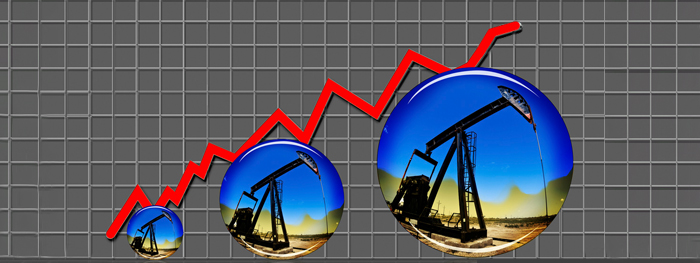 Rising Oil Prices Could Pose the Latest Threat to the Economy
Rising Oil Prices Could Pose the Latest Threat to the Economy
Oil prices have increased more than 30% since late June, driving up transportation costs for consumers and businesses and putting financial markets on edge. On September 27, West Texas Intermediate crude — the U.S. benchmark for oil prices — topped $93 per barrel, the highest level since August 2022. Brent crude (the global oil benchmark) rose above $96.1

As usual, gasoline prices have followed suit. On September 27, the national average price for a gallon of unleaded gas was $3.83, up from $3.75 a year earlier. The price in California, the most expensive state for gasoline, averaged $5.89 per gallon.2
Here’s a look at market dynamics that have impacted fuel prices in recent months, adding to concerns about broader inflation and the nation’s economic prospects.
Tight Oil Supplies
Oil prices are sensitive to shifts in the delicate balance between supply and demand in the global market. Much of the third quarter’s increase has been attributed to a combination of record-high global demand and coordinated supply cuts.3 On September 5, Saudi Arabia and Russia announced the extension of voluntary production cuts (1.3 million barrels per day combined) through the end of 2023. These cuts, which began in June, are on top of cuts that were previously put in place through 2024 by the Organization of the Petroleum Exporting Countries (OPEC), along with Russia and other allied oil producers (dubbed OPEC+). In total, supply cuts are expected to reduce global crude inventories by 3.3 million barrels per day in Q4 2023.4
OPEC is a coalition of 13 member countries, led by Saudi Arabia, that regulate their output to support oil prices. OPEC joined forces with the 10 OPEC+ countries in 2016 so they would have more power to influence prices. The two groups produced about 59% of the world’s supply of crude in 2022.5
Even so, OPEC does not have the iron grip on the oil market that it once wielded. Due to advances in shale drilling methods, U.S. oil production has more than doubled since 2011. The United States has been the top oil-producing nation since 2018 and was responsible for 20% of the world’s total in 2022. Saudi Arabia and Russia followed behind with 12% and 11%, respectively.6
Pain at the Pump
Crude accounted for 57% of the nationwide cost of a gallon of gas in 2022, with the remainder reflecting refining costs, marketing and distribution, and taxes. Moreover, market conditions and gas prices vary widely by state and region.7
Gas prices also respond to seasonal demand shifts. For example, they tend to climb in the summer, when more drivers hit the road for vacations, then decline in the fall. In addition to the rising cost of crude, extreme heat in 2023 forced refineries in the Southeast to operate below capacity for safety reasons, pushing up prices even more than would be typical in the summer.8
On the bright side, the national average gas price is still well below the record of $5.02 set in June 2022, when global oil costs spiked in the months following Russia’s invasion of Ukraine. And most states switch to a cheaper winter blend by October, which could deliver some price relief.9
Will U.S. Drilling Fill the Gap?
Gasoline and heating oil (both derived from crude) are essential expenses for many households, which may leave them with less money to spend on other goods and services. A broad pullback in consumer spending — which accounts for about two-thirds of U.S. gross domestic product (GDP) — could take a significant toll on growth.10
Extended periods of high oil prices have been blamed for bringing on recessions in the past, and low prices have sometimes provided an economic boost. But this relationship has become more complex as the United States has expanded its presence in the global oil market. The United States has been called a swing producer because production levels often fluctuate in response to market prices. High oil prices tend to benefit producers by pumping up company profits, and they incentivize more hiring and drilling. A surge in drilling could have a positive impact on GDP that offsets some of the negative forces.
But more U.S. production is not guaranteed. With oil prices sitting above $100 per barrel for much of 2022, companies were reluctant to invest in drilling.11 In recent weeks, U.S. producers have reportedly added drilling rigs in the shale oil patch at the fastest rate since November of 2022, but it’s still unknown whether U.S. production will increase enough to lower prices.12
Inflation and the Fed
When fuel costs are high, businesses must decide whether to absorb them — lowering profit margins — or pass them on to consumers, which could reignite inflation across the economy.
Measured by the consumer price index (CPI), inflation increased 0.6% in August and was up 3.7% over the previous year. A 10.6% surge in gasoline prices was responsible for more than half of that monthly increase.13
The Federal Reserve has been raising interest rates aggressively to control inflation by slowing economic activity. Despite the rate hikes, the economy has remained surprisingly strong, so higher fuel costs may actually help the Fed’s efforts to slow the pace. Even so, the inflationary effects associated with rising oil prices appear to be another risk to the economic outlook that Fed policymakers must consider as they decide the future path of interest rates.





 Rising Oil Prices Could Pose the Latest Threat to the Economy
Rising Oil Prices Could Pose the Latest Threat to the Economy